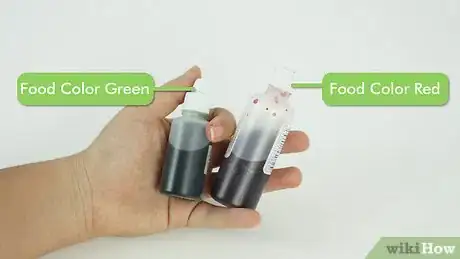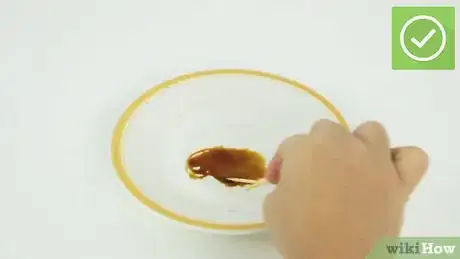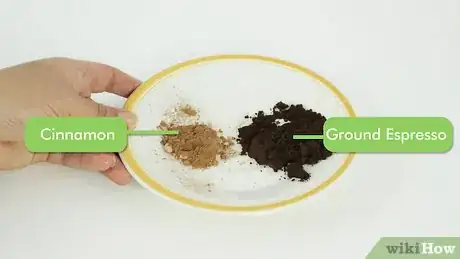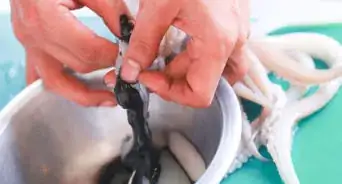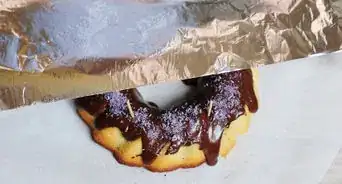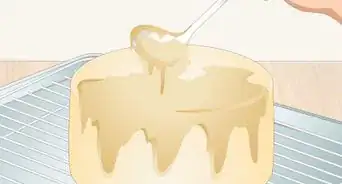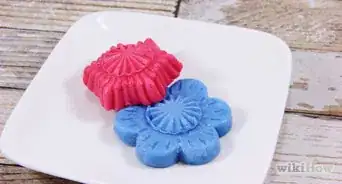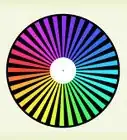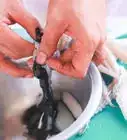This article was co-authored by wikiHow Staff. Our trained team of editors and researchers validate articles for accuracy and comprehensiveness. wikiHow's Content Management Team carefully monitors the work from our editorial staff to ensure that each article is backed by trusted research and meets our high quality standards.
This article has been viewed 706,956 times.
Learn more...
If you don't have brown food coloring on hand or don't want to go with the store-bought variety, there are ways to mix it up yourself at home. Read on to learn how to blend colors for that perfect brown and how to use common edibles like cocoa and coffee to make a natural brown with a little flavor kick.
Steps
Mixing Food Coloring
-
1Find two colored dyes that are opposites on the color wheel. Red and green, orange and blue, or yellow and purple can all be combined to make brown.[1]
- You can use liquid or gel food dye. Gel food dye is usually preferred because you don't need very much to get vivid colors.
-
2Mix the color in a 1:1 ratio. So for every 1 drop of red, add 1 drop of green.[2]
- Mix your colors in a glass or stainless steel bowl. The dye can stain plastic bowls.
Advertisement -
3Play with the addition of colors until you reach the desired shade of brown.
-
4Remember that brown dye will darken as it dries. You may think you have the perfect shade of espresso brown and then find the next day that is has deepened to almost black. Mix your dye lighter than you think you want so it has room to develop.[5]
- If you are dying frosting, consider making it 1-2 days ahead of time so you know the true shade you are working with.[6]
- If your frosting still isn't dark enough, add a drop of black dye or more of your brown.
- If your frosting is too dark, add a little of the white frosting to dilute the color.
-
5Add your dye a little at a time. It often takes a lot of brown dye to make a rich color, but you risk ruining your frosting, playdough, etc. by drowning it in liquid.
Making Natural Food Coloring
-
1Choose your colorant. The colorant is what will provide the brown coloring for the dye. You can use ground espresso, instant coffee, cocoa powder, cinnamon, or black tea achieve brown.[7]
- Remember that you may need a lot of dye to get a very dark brown, which means you will also get a stronger taste of the colorant. Cinnamon is great for light brown, but the taste might be overwhelming if you make a dark brown.[8]
- Used in small amounts, you should not taste the colorant. It's ok to use a dill seed-based colorant for your buttercream if you use it very sparingly.[9]
- You may not be able to get the same vivid colors with natural dye as you would with store-bought colors. Petroleum-based colors need only a few drops to add color, whereas you might need a lot of natural dye to add color. Most recipes will be ruined by the addition of too much coloring--they will taste weird or become too watery to use.[10]
-
2Steep colorants in water to make liquid dye. For every 1 cup of water, add 1 cup coffee, 1/2 cup cocoa, 10 tea bags, or 4 tablespoons of spice.[11]
- Bring the water and colorant mixture to a boil.
- Boil gently or simmer between 15-30 minutes.
- Allow mixture to cool to room temperature.
- Pour mixture through a fine mesh strainer to catch any unabsorbed granules. Store in a glass or stainless steel bowl, as the dye will not stain these materials.
-
3Grind colorants in a coffee or spice grinder to make a powder dye. The key to a powder dye is that it must be extremely fine. If any of your colorants are coarse (like crystals of instant coffee), grind them further until they are a powdery consistency.[12]
- Powder dyes are more concentrated, so you may be able to get a darker color using less of the powder dye. Keep in mind that too much can change the flavor of whatever you are dyeing.[13]
-
4Add your dye a little at a time. Remember that too much liquid dye can ruin the texture and structure of whatever you are dyeing, especially frosting. Too much liquid or powder dye can affect the flavor, so be sure to taste as you go.
- Make peace with the idea that you may not get the dark, vivid color you want from natural dye. Flavor and consistency is ultimately more important than getting that perfect shade.
Community Q&A
-
QuestionWhen starting with green, how do I get tan or beige?
 KaiLittlePonyCommunity AnswerAdd a few drops of pink, depending on the shade of beige you want. The more pink you add, the darker beige it will be.
KaiLittlePonyCommunity AnswerAdd a few drops of pink, depending on the shade of beige you want. The more pink you add, the darker beige it will be. -
QuestionHow do I make brown using gels?
 Community AnswerI have found that red and green work best.
Community AnswerI have found that red and green work best. -
QuestionI need to color a cloth doll's face brown. How can I do this?
 Community AnswerI like to steep some tea and soak the cloth. The longer it soaks, the darker the color will be.
Community AnswerI like to steep some tea and soak the cloth. The longer it soaks, the darker the color will be.
Things You'll Need
Mixing Food Coloring:
- Glass or stainless steel bowl
- Food coloring in primary colors (red, green, and blue)
Natural Food Coloring:
- Water
- Stove
- Pot
- Strainer
- Glass or stainless steel bowl
- Espresso, instant coffee, cocoa powder, cinnamon, or black tea
- Coffee or spice grinder
References
- ↑ http://www.cakecentral.com/forum/t/602105/how-to-make-brown-icing-wout-brown-food-coloring#mbjCUjuTLLxBr9z7.99
- ↑ http://www.cakecentral.com/tutorial/20151/how-to-color-your-icing
- ↑ http://www.ehow.com/how_4797156_make-brown-food-coloring.html
- ↑ http://www.ehow.com/how_4797156_make-brown-food-coloring.html
- ↑ http://www.sweetsugarbelle.com/2012/11/chocolate-brown-icing/
- ↑ http://www.sweetsugarbelle.com/2012/11/chocolate-brown-icing/
- ↑ http://nourishingjoy.com/homemade-natural-food-dyes/
- ↑ http://nourishingjoy.com/homemade-natural-food-dyes/
- ↑ http://nourishingjoy.com/homemade-natural-food-dyes/
About This Article
The easiest way to make brown food coloring is to mix equal amounts of red and green food coloring together. Adding a drop of blue food coloring if you want to make a cooler shade of brown. To make natural brown food coloring, add 1 cup (80 g) of coffee grounds or ½ cup (50 g) of cocoa powder to a pot with 1 cup (240 mL) of water. Bring the water to a boil, then reduce to a simmer for 15-20 minutes. Once the mixture cools to room temperature, strain it through a fine-mesh strainer. Add the liquid dye to your recipe just like you would with store-bought food coloring. To learn how to make brown food coloring with natural ingredients, scroll down!
